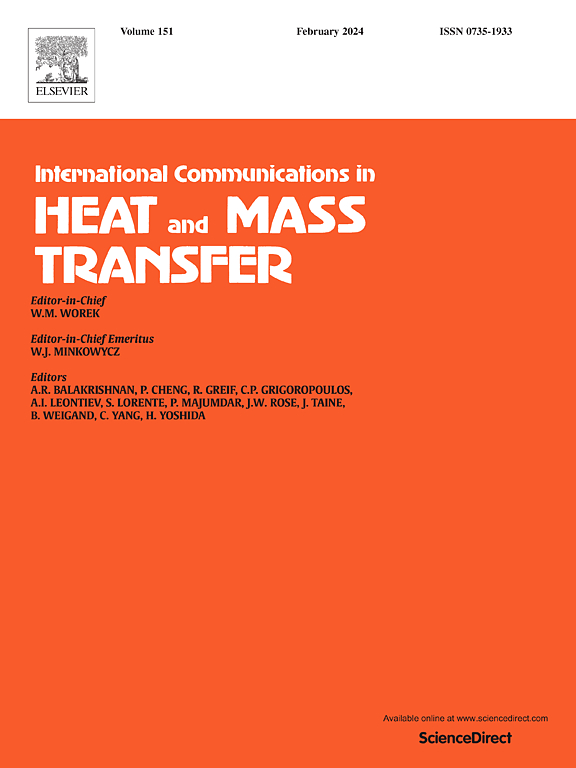沸腾流系统界面面积浓度模拟
IF 6.4
2区 工程技术
Q1 MECHANICS
International Communications in Heat and Mass Transfer
Pub Date : 2025-06-07
DOI:10.1016/j.icheatmasstransfer.2025.109193
引用次数: 0
摘要
界面面积浓度(IAC)或Sauter平均直径(SMD)的精确建模对于沸腾两相流的稳健分析至关重要。IAC与孔隙率(VF)和SMD密切相关,即IAC = 6 × VF/SMD。由于可靠的一维漂移通量相关性可用于预测VF,因此只要准确预测SMD,就可以确定IAC。本研究引入了一种新的方法,将气泡雷诺数、粘度数、VF和密度比作为关键参数,系统地建立了沸腾流动的SMD模型。该模型在多种流动条件下进行了验证,包括过冷和饱和沸腾流动(热平衡质量为- 0.3至0.1),不同的通道几何形状(圆形管道、子通道和环空)和流体介质(水、R-113和R-12),水力直径为17.7-34.6 mm,表面气速为0.01-2.4 m/s,表面液速为0.16-2.8 m/s, VF为0.01-0.47,压力为0.10-2.7 MPa,质量通量为150-3000 kg/m2s,密度比为0.0006-0.17。该模型捕获了SMD对VF的不同行为,并表现出良好的预测性能,预测结果与实验数据吻合良好。SMD和IAC预测的平均绝对百分比误差分别为19.0%和22.9%,表明它们具有较高的可靠性。本文章由计算机程序翻译,如有差异,请以英文原文为准。
Modeling interfacial area concentration for boiling flow systems
Accurately modeling the interfacial area concentration (IAC) or Sauter mean diameter (SMD) is critical for robust analyses of boiling two-phase flows. IAC is closely related to the void fraction (VF) and SMD, i.e., IAC = 6 × VF/SMD. Since reliable one-dimensional drift-flux correlations are available to predict VF, IAC can be determined, provided SMD is accurately predicted. This study introduced a new methodology that systematically developed an SMD model for boiling flows by incorporating bubble Reynolds number, viscosity number, VF, and density ratio as key parameters. The model validation was conducted for a wide range of flow conditions, consisting of both subcooled and saturated boiling flows (thermal equilibrium quality from −0.3 to 0.1), different channel geometries (circular pipes, subchannels, and annuli) and fluid media (water, R-113, and R-12), hydraulic diameters of 17.7–34.6 mm, superficial gas velocities of 0.01–2.4 m/s, superficial liquid velocities of 0.16–2.8 m/s, VF of 0.01–0.47, pressures of 0.10–2.7 MPa, mass fluxes of 150–3000 kg/m2s, and density ratios of 0.0006–0.17. The proposed model captured distinct behaviors of SMD against VF and demonstrated excellent predictive performance with good agreement between predictions and experimental data. The mean absolute percentage errors for SMD and IAC predictions were 19.0 % and 22.9 %, respectively, indicating their high reliability.
求助全文
通过发布文献求助,成功后即可免费获取论文全文。
去求助
来源期刊
CiteScore
11.00
自引率
10.00%
发文量
648
审稿时长
32 days
期刊介绍:
International Communications in Heat and Mass Transfer serves as a world forum for the rapid dissemination of new ideas, new measurement techniques, preliminary findings of ongoing investigations, discussions, and criticisms in the field of heat and mass transfer. Two types of manuscript will be considered for publication: communications (short reports of new work or discussions of work which has already been published) and summaries (abstracts of reports, theses or manuscripts which are too long for publication in full). Together with its companion publication, International Journal of Heat and Mass Transfer, with which it shares the same Board of Editors, this journal is read by research workers and engineers throughout the world.

 求助内容:
求助内容: 应助结果提醒方式:
应助结果提醒方式:


